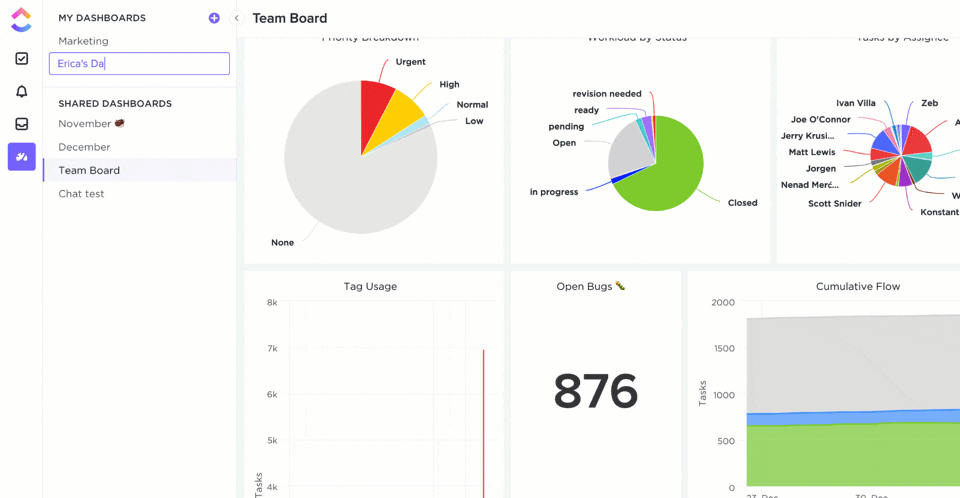

Whether you’re a sales manager or just a junior sales representative, there’s one thing we can all agree on:
Selling products is a daunting job.
Imagine this:
It’s your first day as a sales rep, and you’ve been assigned door-to-door sales.
You’re not sure if you’re going to open a door of opportunity or if the door will be slammed in your face. 🚪
You might not even feel adequately trained or know what your targets are.
But, that wouldn’t be the case with OKRs!
OKRs can improve your sales team’s skillset and make them feel more confident since they have a goal and strategy in mind.
In this article, we’ll cover what sales OKRs are, ten excellent examples of OKRs for sales, and showcase the best project management software to help you manage and track those OKRs.
Let’s get started!
What Are OKRs in Sales?
OKR stands for Objectives and Key Results.
OKRs are a goal setting framework that helps teams develop and achieve their goals.
Actually, OKRs are quite similar to SMART goals.
How?
They encourage you to be specific about what you want, establish a timeline, and align your goals. The difference between the two is that OKRs also give you a step-by-step plan to reach success.
Check out some cool OKR examples we use at ClickUp!
But how does the OKR framework apply to sales teams?
An OKR in sales helps your team develop sales goals. Each team member can choose which key result they can focus on to contribute to the collective goal.
You can also track your OKR progress and performance every day to avoid getting hit with sudden disappointment.
5 Tips For Writing Effective Sales OKRs
Before you go ahead and set your objectives, here are a few tips that can help you write an effective OKR:
1. Specific
Make sure you clearly define what you want to accomplish and how you’re going to do it.
2. Measurable
You need to work towards a measurable goal. You can do this by deciding on what key metric or (KPI) you’ll be using.
3. Timely
Your OKRs need to have a target date. Without one, you and your team could be working on the same goal indefinitely:

Almost there, guys.
4. Aligned
Check that your objective is relevant, contributes to your career, and connects with the overall company goal.
5. Ambitious
OKRs are supposed to inspire others, so don’t be afraid to reach for the stars! 🤩
Need more tips? Here’s a guide on how to write effective OKRs.
10 Sales OKR Examples
We’re offering you a great deal of 10 OKR examples for sales that any sales manager couldn’t refuse!
Let’s take a look:
A. Sales team OKRs
Sales team OKRs are the goals that your sales team can work together on to achieve.
These OKRs can include goals like speeding up specific sales processes or creating the dream sales team like these two:

Well, they were a dream team when they weren’t busy pranking each other.
Let’s get back to those Sales OKR examples:
1. Objective: Improve our sales department performance by 15%
Key Results:
- Maintain a sales pipeline of qualified leads at a value of $250K every quarter
- Increase our closing rate from 15% to 30%
- Implement a balanced scorecard to evaluate our performance
- Increase scheduled calls per sales rep from two per week to seven
2. Objective: Speed up our sales cycle from 8 months to 6 months by the beginning of the third quarter.
Key Results:
- Decrease the time taken from the first call to demo by 40%
- Decrease the time taken from the demo phase to closing by 35%
- Improve our sales process by implementing a new sales training program
3. Objective: Improve the efficiency of our sales team
Key Results:
- Conduct monthly training sessions for each stage of the customer lifecycle
- Increase conversion rate from 10% to 30%
- Receive positive feedback from 90% of our customers about the efficiency of our sales team
B. Revenue management OKRs
Revenue management OKRs help you keep your eyes on the prize.

That’s right! These goals aim to make you mo’ money 💰.
4. Objective: Increase annual recurring revenue by 50% by the third quarter.
Key Results:
- Reach monthly recurring revenue of $150k
- Increase sales from 15% to 40%
- Implement a new customer acquisition process by the end of the second quarter
- Reduce churn rates to less than 3% every month
5. Objective: Achieve record revenues while increasing profitability by the fourth quarter
Key Results:
- Reach quarterly revenue of $75,000
- Expand our sales ventures to two new countries this quarter
- Increase gross profit margin from 17% to 45%
6. Objective: Increase our sales funnel size by 45% by the fourth quarter
Key Results:
- Increase the number of salespersons by 20%
- Get 40 lead conversions daily
- Reduce the number of lost leads by 20%
C. Product marketing OKRs
You can’t sell a product if no one even knows about it, right?
That’s what product marketing OKRs are all about!
It’s about coming up with ideas like promotions, deals, and marketing campaigns that will catch someone’s eye:

7. Objective: Create new product marketing content by the second quarter
Key Results:
- Have the marketing team write 15 promotional posts
- Get our product to appear in 10 positive reviews
- Increase the number of product demo videos from 7 to 20
8. Objective: Relaunch the company blog by the end of the first quarter
Key Results:
- Create and publish two articles per week for our blog
- Increase the number of blog subscribers from 2500 to 5000
- Increase our Facebook followers from 900 to 3000
D. Customer OKRs
Customer OKRs focus on…
Drum roll, please.
Your customers!
These OKRs are about making sure your existing customers are happy with your product so that your customers don’t disappear on you:

9. Objective: Increase our user base by 45% by the fourth quarter.
Key Results:
- Increase number of paid users from 500 to 1000
- Boost our inbound conversion rate from 10% to 20%
- Increase our outbound leads from 10/week to 30/week
10. Objective: Improve customer engagement by 35% by the second quarter.
Key Results:
- Increase monthly customer retention rates from 30% to 60%
- Increase the average time spent on our website from 15 minutes to 25 mins
- Increase the number of times different users go on our app from 10 to 25 times a day
Why You Should Use OKRs
Here are three reasons why OKRs are super crucial for sales reps:
1. Increases Clarity
The OKR methodology makes sure that teams have a crystal-clear understanding of what’s expected of them.💎
OKRs also encourage large organizations to connect company, team, and personal objectives to a measurable result. This way, the entire company can move together in the right direction.
Additionally, OKRs keep teammates accountable since everyone is responsible for the same goals, or in other words…

2. Improves Focus
Checking your OKR progress annually or quarterly isn’t enough!
OKRs require regular check-ins.
This means that you need to track them weekly or even daily.
Feeling demotivated?
Seeing the progress you’ve made towards your OKR goal and reminding yourself why you’re doing this can make you even more productive!
3. Boost Employee Engagement
It’s basically impossible to achieve a large company OKR on your own.
You’ll always need your teammates somewhere along the line, right?
Team and company OKRs ensure that every team member is involved in the OKR process.
Every employee has a unique role to play!
By letting them know that they’re an asset to the company, your employees will become more enthusiastic and engaged. 😄
In no time, your employees will wake up every morning feeling like this:

The Best Way To Manage Your Sales OKRs
A great salesperson knows that you’ll never close a sale by contacting a customer only once.
To close sales successfully, you need to keep track of your prospects by sending them follow-up emails on a regular basis.
Similarly, you can’t just set OKRs, and hope that you’ll achieve them.
You also need to track and manage them constantly!
So how do you do this?
The answer lies in OKR software!
An OKR tracking tool like ClickUp can help you set, track, and manage all your product OKRs.
Here’s how ClickUp can help:
1. Goals Setting (Objectives)
Goals are high-level containers that can be broken down into smaller, measurable Targets.

This means that:
- Your objectives = ClickUp Goals
- Your key results = ClickUp Targets
Here’s how you can create Goals in ClickUp:
Go to “Goals” in ClickUp and create a new Goal by clicking the “+ New Goal” button.
You can also edit details about your Goals:
- The title of your Goal
- The due date of your Goal
- Who has to achieve the Goal
- Who has access to your Goal
- The Goal description

Goals can play a significant role in keeping you motivated and accountable, so you don’t spend your day binge-watching your favorite shows!

Not sure how to go about setting goals? Here are 7 steps to efficiently set team goals.
2. Targets
Now that you have your OKR objective in place, you need a few key results or Targets.
Simply add a Target by clicking on the “Add Target” button.
Your Targets will then appear right below your overall Goal.

You can also edit details about your Targets like:
- The title of your Targets
- Who’s responsible for the Targets
- The type of Target
Here are the different types of Targets you can set in ClickUp:
- Number: numerical figures such as the revenue generated from door-to-door sales
- True/False: enter if something has been done or not
- Currency: keep track of your money
- Tasks: track the number of sales activities that have completed. For example, checking if every team member has enough leads for the week

3. Tracking Progress
Once your Goal (objectives) and Targets (key results) are ready to go, you need a sales analytics process to stay on target and track your progress towards those OKRs.
Here’s what you can track:
1. Your progress for each Target (key result)
For example, if you have a key result to close ten sales per week, you can see how many you’ve closed so far.

2. How your Target (key result) progress has contributed to your Goal’s (objective) progress
For example, if you’ve completed less than a quarter of your Targets so far, your progress will be 20%.

4. Dashboards and Widgets
Dashboards give you a high-level overview of all that’s going on in your company.
You can see your OKR progress through things like completed tasks and the time taken for specific projects.

You can also add Custom Widgets to your Sales Dashboard.
Widgets give you detailed insights into tasks, Sprints, people, and projects.
Here’s a list of some of the Widgets you can choose from:
- Sprint: get insight into the progress you’ve made with your Sprints 🏃
- Text Block: add rich text, images, and even use /slash commands to add context to your Dashboards
- Calculations: calculate sums, averages, and so much more for any tasks in your Workspace
- Assignee: shows you how many tasks each member of your team is working on, and any uncompleted tasks
- Table: see which tasks have been completed, who has closed the most deals, and which team members need a little more motivation!

Sales OKRs FAQs
Here are the answers to some essential questions you probably have about OKRs:
1. What Are Personal OKRs?
Personal OKRs are the goals you have for your personal life.
These goals can be anything that you want to accomplish in your life.
Here’s a personal OKR example:
Objective: Have a fantastic trip to Italy after the pandemic.
Key Results:
- Save up! 💰
- Create a well-rounded itinerary 📋
- Get all the required documents in place 📁
- Try out at least 10 different wines 🍷
- Do some weather research and pack accordingly 🌂
This way, you won’t feel completely unprepared or out of place on your trip!

2. What Are Individual OKRs?
An individual OKR encourages employees to focus on their own goals for work.
Here’s an individual OKR template:
Objective: Close 20 deals per month.
Key Results:
- Call at least 50 prospects per day
- Give product demos to 50 customers a week
- Follow up with 10 lost deals to learn what went wrong
The problem with individual goals is that it limits the teamwork aspect of OKRs since employees tend to shift their focus to only their individual performance.
3. What Are Team OKRs?
Team OKRs are the perfect solution to individual OKRs.
Why?
Team OKRs are goals that rely on the combined effort of every team member. They require task delegation and collaboration for success.
This means that when one team member shines, the whole team shines✨.
4. What Are Quarterly OKRs?
Quarterly OKRs are goals that are set for every quarter (three months).
Think of it like this: You have a giant pizza (your annual OKR).

But you cut that pizza into four slices (four OKRs), and you eat one piece (complete one OKR) each quarter. 🍕
Why not just eat the delicious pizza as a whole? 🙄
Here’s why:
By breaking it down into four easy-to-digest steps, teams can work towards a quarterly objective that’s more attainable and see results faster.
Also, shorter timelines keep goals relevant.
What do we mean?
It’s easier to predict what will happen in three months than it is for a year!
So if something does go wrong, you’ll be able to deal with it with the greatest of cheese …we mean ease.
Time To Seal The Deal ✅
Sales OKRs help you set ambitious sales goals and map out the steps to get there.
However, having a list of effective sales OKRs isn’t all it takes to reach success.
You still need to work towards those OKRs on a daily basis.
Lucky for you, you can count on a fantastic OKR tracking tool like ClickUp!
With built-in Reminders, Task Checklists, and Assigned Tasks, you’ll have everything you need to stay on top of your sales OKRs.
Get ClickUp for free today to hit all your sales targets with 100% accuracy. 🎯



Questions? Comments? Visit our Help Center for support.